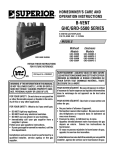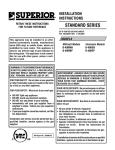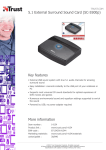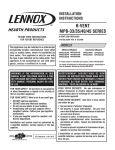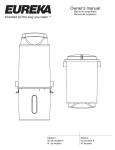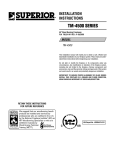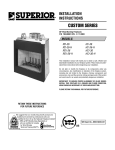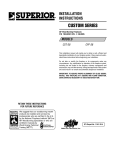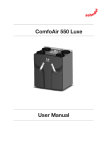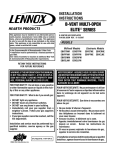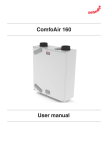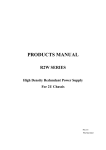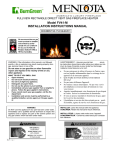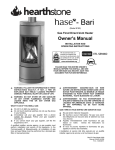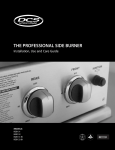Download Superior GHC/GRD-5500 User's Manual
Transcript
INSTALLATION INSTRUCTIONS RETAIN THESE INSTRUCTIONS FOR FUTURE REFERENCE This appliance may be installed in an aftermarket permanently located, manufactured home (USA only) or mobile home, where not prohibited by local codes. This appliance is only for use with the type of gas indicated on the rating plate. This appliance is not convertible for use with other gases, unless a certified kit is used. For GHC/GRD-5500 WH Report No. J20046562 For GHC/GRD-6500 WH Report No. J20046564 WARNING: IF THE INFORMATION IN THIS MANUAL IS NOT FOLLOWED EXACTLY, A FIRE OR EXPLOSION MAY RESULT CAUSING PROPERTY DAMAGE, PERSONAL INJURY OR LOSS OF LIFE. FOR YOUR SAFETY: Do not store or use gasoline or other flammable vapors or liquids in the vicinity of this or any other appliance. FOR YOUR SAFETY: What to do if you smell gas: • • • • DO NOT light any appliance. DO NOT touch any electrical switches. DO NOT use any phone in your building. Immediately call your gas supplier from a neighbor’s phone. Follow your gas suppliers instructions. • If your gas supplier cannot be reached, call the fire department. Installation and service must be performed by a qualified installer, service agency or the gas supplier. B-VENT GHC-5500/6500 AND GRD-5500/6500 SERIES B-VENTED GAS FIREPLACES P/N 700,027M REV. E 07/2004 MODELS Millivolt Models Electronic Models GHC-5500N GHC-5500P GRD-5500N GRD-5500P GHC-6500N GHC-6500P GRD-6500N GRD-6500P GHC-5500NE-2 GHC-5500PE-2 GRD-5500NE-2 GRD-5500PE-2 GHC-6500EN GHC-6500EP GRD-6500EN GRD-6500EP AVERTISSEMENT: ASSUREZ-VOUS DE BIEN SUIVRE LES INSTRUCTIONS DONNÉ DANS CETTE NOTICE POUR RÉDUIRE AU MINIMUM LE RISQUE D'INCENDIE OU POUR ÉVITER TOUT DOMMAGE MATÉRIEL, TOUTE BLESSURE OU LA MORT. POUR VOTRE SÉCURITÉ: Ne pas entreposer ni utiliser d'essence ni d'autre vaperurs ou liquides inflammables dans le voisinage de cet appareil ou de tout autre appareil. POUR VOTRE SÉCURITÉ: Que faire si vous sentez une odeur de gaz: • Ne pas tenter d'allumer d'appareil. • Ne touchez à aucun interrupteur. Ne pas vous servir des téléphones se trouvant dans le batiment où vous vous trouvez. • Evacuez la piéce, le bâtiment ou la zone. • Appeflez immédiatement votre fournisseur de gaz depuis un voisin. Suivez les instructions du fournisseur. • Si vous ne pouvez rejoindre le fournisseur de gaz, appelez le service dos incendies. L'installation et service doit être exécuté par un qualifié installer, agence de service ou le fournisseur de gaz. NOTE: DIAGRAMS & ILLUSTRATIONS NOT TO SCALE. 1 TABLE OF CONTENTS Packaging ........................................ page Introduction ..................................... page General Information ......................... page Location .......................................... page Appliance Specifications - 5500 ...... page Appliance Specifications - 6500 ...... page Venting ............................................ page Clearances ....................................... page Framing Specifications .................... page Typical Installation Sequence .......... page Pre-Installation Notes ...................... page Installation ....................................... page Field Wiring ..................................... page Connecting Gas Line ........................ page Outside Air Kit Installation ............... page Log and Rockwool Installation ........ page Appliance Operation ........................ page Millivolt Appliance Checkout ............ page Electronic Appliance Checkout ......... page Safety Limit Switch Operation ......... page Adjustments .................................... page Finishing Requirements ................... page Cold Climate Insulation .................... page Installation Accessories ................... page Gas Conversion Kits .................. page 2 2 2 3 4 5 6 6 6 7 7 8 9 11 11 12 12 12 13 13 14 14 16 16 16 This installation manual will help you obtain a safe, efficient, dependable installation for your appliance and vent system.Please read and understand these instructions before beginning your installation. PACKAGING The assembled vented gas fireplace is packaged with: 1 - one cartoned log set located in firebox area. 2 - one bag of glowing embers (rockwool) located in the bottom compartment. 3 - one envelope containing the literature package which consists of the homeowner's manual, installation instructions, and warranty; envelope is located in the control area. 4 - wall switch for burner operation taped to top of unit. INTRODUCTION The GHC-5500/6500N, P models are circulating system appliances; the GRD-5500/6500N, P models are radiant heat system appliances; both types utilize a millivolt gas control valve and a piezo ignition system. There is no need for an external power source to operate these systems. They are designed to operate on either natural or propane gas. 2 The GHC-5500NE-2, PE-2 and GHC-6500EN, EP models are circulating system appliances; the GRD-5500NE-2, PE-2 and GRD-6500EN, EP models are radiant heat system appliances; both utilize an electronic gas control valve along with an intermittent ignition system. These systems require an external power source in order to operate. They are designed to operate on either natural or propane gas. These appliances comply with National Safety Standards and are tested and listed by Warnock Hersey (Report No. J20046562 - for 5500 series; J20046564 - for 6500 series models) to ANSI Z21.50 - 2000 (in Canada, CSA 2.22 2000), and CAN/CGA-2.17-M91 in both USA and Canada, as vented gas fireplaces. Installation must conform to local codes. In the absence of local codes, installation must comply with the current National Fuel Gas Code, ANSI Z223.1 (NFPA 54). (In Canada, the current CAN/CGA B149 installation code.) Electrical wiring must comply with local codes. In the absence of local codes, installation must be in accordance with the National Electrical Code, NFPA 70 - (latest edition). (In Canada, the current CSA C22.1 Canadian Electric Code.) DO NOT ATTEMPT TO ALTER OR MODIFY THE CONSTRUCTION OF THE APPLIANCE OR ITS COMPONENTS. ANY MODIFICATION OR ALTERATION MAY VOID THE WARRANTY, CERTIFICATION AND LISTINGS OF THIS UNIT. WARNING: IMPROPER INSTALLATION, ADJUSTMENT, ALTERATION, SERVICE OR MAINTENANCE CAN CAUSE INJURY OR PROPERTY DAMAGE. REFER TO THIS MANUAL. FOR ASSISTANCE OR ADDITIONAL INFORMATION CONSULT A QUALIFIED INSTALLER, SERVICE AGENCY OR THE GAS SUPPLIER. GENERAL INFORMATION Note: Installation and repair should be performed by a qualified service person. The appliance should be inspected annually by a qualified professional service technician. More frequent inspections and cleanings may be required due to excessive lint from carpeting, bedding material, etc. It is imperative that the control compartment, burners and circulating air passage ways of the appliance be kept clean. S'assurer que le brùleur et le compartiment des commandes sont propres. Voir les instructions d'installation et d'utilisation qui accompagnent l'apareil. NOTE: DIAGRAMS & ILLUSTRATIONS NOT TO SCALE. Provide adequate clearances around air openings and adequate accessibility clearance for service and proper operation. Never obstruct the front openings of the appliance. WARNING: THESE FIREPLACES ARE VENTED DECORATIVE GAS APPLIANCES. DO NOT BURN WOOD OR OTHER MATERIAL IN THESE APPLIANCES. These appliances are designed to operate on natural or propane gas only. The use of other fuels or combination of fuels will degrade the performance of this system and may be dangerous. For elevations of 0-2000 ft. (0-610 m.) the GHC/GRD-5500 input is 24,000 BTU/HR for both natural and propane gases, the GHC/ GRD-6500 input is 27,000 BTU/HR for both natural and propane gases. Table 1 shows the units' factory-installed gas orifice size for installations at elevations of 0-2000 feet (0-610 meters). GHC GRD Series Orifice size Nat. Prop. 5500 #43 #54 6500 #41 #53 Elevation Feet (meters) 0-2000 (0-610) Table 1 Table 2 shows the units' gas orifice size for installations at elevations greater than 2000 ft. (0-610 m.). These orifices must be ordered separately using the kit numbers listed in table 2. GHC GRD Series Orifice size (Kit Number) Nat. Prop. 5500 #44 (040611) #55 (040612) 6500 #43 (051916) #55 (051917) Elevation Feet (meters) greater than 2000 (610) Table 2 Nominal operating pressures for the manifold side of the gas control system are; 3.5 inches water column (6.54 MmHg) for natural gas models and 10 inches water column (18.69 MmHg) for propane gas models. Do not use these appliances if any part has been under water. Immediately call a qualified, professional service technician to inspect the appliance and to replace any parts of the control system and any gas control which have been under water. These appliances must not be connected to a chimney or flue serving a separate solid fuel burning appliance. Ne pas se servir de cet appareil s'il a été plongé dans l'eau, complètement ou en partie. Appeler un technicien qualifié pour inspecter l'appareil et remplacer toute partie du système de contrôle et toute commande qui ont été plongés dans l'lau. WARNING: FAILURE TO COMPLY WITH THE INSTALLATION AND OPERATING INSTRUCTIONS PROVIDED IN THIS DOCUMENT WILL RESULT IN AN IMPROPERLY INSTALLED AND OPERATING APPLIANCE, VOIDING ITS WARRANTY. ANY CHANGE TO THIS APPLIANCE AND/OR ITS OPERATING CONTROLS IS DANGEROUS. IMPROPER INSTALLATION OR USE OF THIS APPLIANCE CAN CAUSE SERIOUS INJURY OR DEATH FORM FIRE, BURNS, EXPLOSION OR CARBON MONOXIDE POISONING. This appliance may be installed in an aftermarket permanently located, manufactured home (USA only) or mobile home, where not prohibited by local codes. This appliance is only for use with the type of gas indicated on the rating plate. This appliance is not convertible for use with other gases, unless a certified kit is used. Cet appareil peut être installé dans un maison préfabriquée (É.-U. seulement) ou mobile déjà installée à demeure si les réglements locaux le permettent. Cet appareil doit être utilisé uniquement avec les types de gaz indiqués sur la plaque signalétique. Ne pas l'utiliser avec d'autres gaz sauf si un kit de conversion certifié est installé. Millivolt appliances may be fitted at time of manufacture with either a Robertshaw millivolt gas control valve or Robertshaw electronic gas control valve. Both valves have been tested with and approved for use with these appliances and are listed accordingly. A ¹⁄₈" NPT test gage connection is provided on either gas control valve adjacent to the outlet to the main burner. Minimum inlet gas pressure to the appliance is 4.5 inches water column (1.12 kPa) for natural gas and 11 inches water column (2.74 kPa) for propane for the purpose of input adjustment. Maximum inlet gas supply pressure to the appliance is 10.5 inches water column (2.61 kPa) for natural gas and 13.0 inches water column (3.23 kPa) for propane. The appliance must be isolated from the gas supply piping system (by closing its individual manual shut-off valve) during any pressure testing of the gas supply piping system at test pressures equal to or less than ¹⁄₂ psig (3.5) kPa). The appliance and its individual shut-off valve must be disconnected from the gas supply piping system during any pressure testing of that system at pressures in excess of ¹⁄₂ psig (3.5 kPa). Do not place clothing or other materials on or near this appliance. AVERTISSEMENT: SURVEILLER LES ENFANTS. GARDER LES VÊTEMENTS, LES MEUBLES, L'ESSENCE OU AUTRES LIQUIDES À VAPEUR INFLAMMABLES LIN DE L'APPAREIL. WARNING: THIS APPLIANCE MAY ONLY BE FITTED WITH DOORS CERTIFIED FOR USE WITH THE APPLIANCE. AVERTISSEMENT: POUR UTILISATION UNIQUEMENT AVEC LES PORTES EN VERRE CERTIFIÊES AVEC L'APPAREIL. These appliances are equipped with an integral combustion air door and actuator arm. Combustion air kits are optional. Install as shown in step 7 on page 11. LOCATION Carbon Monoxide Poisoning: Early signs of carbon monoxide poisoning are similar to the flu with headaches, dizziness and/or nausea. If you have these signs, obtain fresh air immediately. Turn off the gas supply to the appliance and have it serviced by a qualified professional, as it may not be operating correctly. WARNING: B-VENT APPLIANCES ARE NOT DESIGNED TO OPERATE IN NEGATIVELY PRESSURED ENVIRONMENTS (PRESSURE WITHIN THE HOME IS LESS THAN PRESSURES OUTSIDE). SIGNIFICANT NEGATIVELY PRESSURED ENVIRONMENTS CAUSED BY WEATHER, HOME DESIGN, OR OTHER DEVICES MAY IMPACT THE OPERATION OF THESE APPLIANCES. NEGATIVE PRESSURES MAY RESULT IN POOR FLAME APPEARANCE, SOOTING, DAMAGE TO PROPERTY AND/OR SEVERE PERSONAL INJURY. DO NOT OPERATE THESE APPLIANCES IN NEGATIVELY PRESSURED ENVIRONMENTS. Typical Locations Figure 1 In selecting the location, the aesthetic and functional use of the appliance are primary concerns. However, vent system routing to the exterior and access to the fuel supply are also important. Due to high temperatures the appliance should be located out of traffic and away from furniture and draperies. Consideration should be given to traffic ways, furniture, draperies, etc., due to elevated surface temperatures. The location should also be free of electrical, plumbing or other heating/air conditioning ducting. WARNING: CHILDREN AND ADULTS SHOULD BE ALERTED TO THE HAZARDS OF HIGH SURFACE TEMPERATURES. USE CAUTION AROUND THE APPLIANCE TO AVOID BURNS OR CLOTHING IGNITION. YOUNG CHILDREN SHOULD BE CAREFULLY SUPERVISED WHEN THEY ARE IN THE SAME ROOM AS THE APPLIANCE. The appliance should be mounted on a fully supported base extending the full width and depth of the unit. The appliance may be located on or near conventional construction materials. However, if installed on combustible materials, such as carpeting, vinyl tile, etc., a metal or wood barrier covering the entire bottom surface must be used. WARNING: DO NOT PLACE CLOTHING OR OTHER FLAMMABLE MATERIALS ON OR NEAR THIS APPLIANCE. These appliances may be used for bedroom installations in the United States and are listed accordingly. These units may not be installed in bedrooms in Canada. NOTE: DIAGRAMS & ILLUSTRATIONS NOT TO SCALE. 3 APPLIANCE SPECIFICATIONS GHC/GRD-5500 GHC-5500 GRD-5500 4 ¹⁄₄" (108 mm) 4 ¹⁄₄" (108 mm) 6 ¹⁄₂" (165 mm) 21" (533 mm) 33 ¹⁄₄" (845 mm) 34 ¹⁄₂" (876 mm) 34 ¹⁄₂" (876 mm) 21" (533 mm) 1 ¹⁄₂" (38 mm) 33 ¹⁄₄" (845 mm) 7" (178 mm) 35 ⁷⁄₈" (911 mm) 35 ⁷⁄₈" (911 mm) Front View Front View Gas Inlet Line Combustion Air Inlet 10 ¹⁄₂" (267 mm) 38 ³⁄₄" (984 mm) 10 " (254 mm) 9 ¹⁄₂" (241 mm) 4 ¹⁄₂" (114 mm) 8 ¹⁄₂" (216 mm) 8 ¹⁄₂" (216 mm) 16" (406 mm) 16" (406 mm) Left View Right View Gas Inlet Line Combustion Air Inlet 38 ³⁄₄" (984 mm) 4 ¹⁄₂" (114 mm) 8 ¹⁄₂" (216 mm) 8 ¹⁄₂" (216 mm) 15" (381 mm) 15" (381 mm) Left View Right View Top Spacers (4) Top Spacers (4) 27 ³⁄₄" (705 mm) 27 ³⁄₄" (705 mm) 6 ¹⁄₂" (165 mm) 6 ¹⁄₂" (165 mm) 15 " (381 mm) 1" (25.4 mm) 15 " (381 mm) 1" (25.4 mm) 35 ⁷⁄₈" (911 mm) 35 ⁷⁄₈" (911 mm) Top View Top View Figure 2 4 9" (229 mm) NOTE: DIAGRAMS & ILLUSTRATIONS NOT TO SCALE. APPLIANCE SPECIFICATIONS GHC/GRD-6500 GHC-6500 GRD-6500 4 ¹⁄₄" (108 mm) 4 ¹⁄₄" (108 mm) 6 ³⁄₈" (162 mm) 6 ¹⁄₂" (165 mm) 21 ¹⁄₂" (546 mm) 21" (533 mm) 32" (813 mm) 21" (533 mm) 16 ¹⁄₄" (413 mm) 36 ¹⁄₄" (921 mm) 37 ³⁄₄" (959 mm) 32" (813 mm) 37 ³⁄₄" (959 mm) 39 ⁷⁄₈" (1013 mm) 1 ¹⁄₂" (38 mm) ¹⁄₂" (13 mm) Spacer 8 ³⁄₄" (222 mm) Combustion Air Inlet 7 ¹⁄₂" (191 mm) 10 ¹⁄₂" (267 mm) 36 ¹⁄₄" (921 mm) 16 ¹⁄₄" (413 mm) 40 ⁵⁄₈" (1032 mm) 40 ⁵⁄₈" (1032 mm) Front View Front View Nailing Flange Nailing Flange Gas Inlet Line ¹⁄₂" (13 mm) Spacer Combustion Air Inlet 40 ¹⁄₂" (1029 mm) 7 ¹⁄₂" (191 mm) 6 ¹⁄₂" (165 mm) 4 ¹⁄₈" (105 mm) 6 ¹⁄₂" (165 mm) ¹⁄₂" (13 mm) Spacer 5" (127 mm) 5" (127 mm) 10 ¹⁄₂" (267 mm) Nailing Flange Nailing Flange Gas Inlet Line 40 ¹⁄₂" (1029 mm) 6 ¹⁄₂" (165 mm) 4 ¹⁄₈" (105 mm) 6 ¹⁄₂" (165 mm) 5" (127 mm) 5" (127 mm) 20" (508 mm) 17 ⁷⁄₈" (454 mm) 19" (483 mm) 17 ⁷⁄₈" (454 mm) Left View Right View Left View Right View Top Spacers (4) Top Spacers (4) 31" (787 mm) 31" (787 mm) 7 ³⁄₄" (197 mm) ¹⁄₂" (13 mm) Spacer ¹⁄₂" (13 mm) 7 ³⁄₄" (197 mm) 17 ⁷⁄₈" (454 mm) 1" (25.4 mm) 40 ⁵⁄₈" (1032 mm) ¹⁄₂" (13 mm) Spacer ¹⁄₂" (13 mm) Spacer ¹⁄₂" (13 mm) ⁵⁄₈" (16 mm) 1 ⁵⁄₈" (41 mm) 17 ⁷⁄₈" (454 mm) 40 ⁵⁄₈" (1032 mm) Top View Top View Figure 3 NOTE: DIAGRAMS & ILLUSTRATIONS NOT TO SCALE. 5 APPLIANCE CLEARANCES Venting Gas Vent Rule – Gas vent caps are not permitted within 8 feet (2.4 mm) of a vertical wall or similar obstruction. Gas vent caps that are located 8' or more from a portion of a building which extends at an angle greater than 45° upward from the horizontal may terminate in accordance with the table in Figure 4, provided that in no case shall any discharge opening on the cap be less than 2' (610 mm) horizontally from the roof surface (National Fuel Gas Code ANSI Z223.1 (NFPA 54) 7.6.2) (CAN/CGA B149). GHC/GRD-5500 GHC/GRD-6500 1/2 in. (13mm) 1/2 in. (13mm) 0 in. (0 mm) to spacers 1/2 in. (13mm)** 1/2 in. (13mm)** 0 in. (0 mm) to spacers Back Sides Top Spacers 0 in. (0 mm) Floor 0 in. (0 mm) *From Bottom of Unit to Ceiling 65 1/2 in. (1664 mm) Vent X 67 1/2 in. (1715 mm) 1 in. (25.4 mm) 12 SERVICE CLEARANCE Roof Pitch is X/12 Front 3 Feet (0.9 meters) * Note: See also Figure 32 on page 14 for an illustration of this clearance, for Minimum Height from Roof to Lowest Discharge Opening clearances to a sidewall and for mantel clearances. **Note: The nailing tabs and the area directly behind the nailing tabs are exempt from the clearances described in the above table. See Figure 9 on page 8. Table 3 Roof Slope Minimum Height from Roof to Lowest Discharge Opening Feet FRAMING SPECIFICATIONS Use Only 2x4 or Larger Lumber Meters Flat to 6/12 1' 0" 0.3 Over 7/12 to 9/12 2' 0" 0.6 Over 10/12 to 12/12 4' 0" 1.2 Over 13/12 to 16/12 6' 0" 1.8 Over 17/12 to 21/12 8' 0" 2.4 Note: If the Outside Combustion Air Kit is to be installed, it must be installed before the appliance is framed and enclosed in the finishing walls. B Note: Venting terminals shall not be recessed into a wall or siding. Header E Gas Supply Line Left or Right Side - 5500 Right Side Only - 6500 Figure 4 D A *C *Note: The framed depth - dimension “C”- from a framed wall, must always be measured from a finished surface. If a wall covering such as drywall is to be attached to the rear wall, then dimension “C” must be measured from the drywall surface. It is important that this dimension be exact. Model No. GHC/GRD-5500 GHC/GRD-6500 Figure 5 6 A B C D E in. 33 1/4 38 3/4 15 1/2 8 1/2 8 1/2 mm 845 984 394 216 216 in. 40 3/4 40 3/4 18 6 1/2 5 mm 1035 1035 457 165 127 NOTE: DIAGRAMS & ILLUSTRATIONS NOT TO SCALE. TYPICAL INSTALLATION SEQUENCE FRAMING SPECIFICATIONS CONTINUED Optional FOAK-4 or FOAK-4LD Outside Air Kit Back Wall of Chase/Enclosure Including Finishing Materials, If Any. Note: If the Outside Combustion Air Kit is to be installed, it must be installed before the appliance is framed and enclosed in the finishing walls. C The typical sequence of installation follows, however, each installation is unique resulting in variations to those described. 1. Construct the appliance framing. D 2. Route gas supply line to appliance location. 3. Position the appliance. 4. Install the vent system and exterior termination. B A Square Housing Not Used on 5500 Model Rough Framing Face (Unfinished Shown) Model No. A GHC/GRD-5500 GHC/GRD-6500 5. Field wire and install operating control switch. Install optional Forced Air Kit, if required B C 6. Make connection to gas supply. D in. 57 1/2 36 40 3/4 29 mm 1461 914 1035 737 in. 65 3/4 40 3/4 46 1/2 32 7/8 mm 1670 1035 1181 835 7. Install optional Outside Combustion Air Kit, if required. 8. Install the logs and rockwool. 9. Install the optional glass doors/enclosure panel, if required Corner Installation Figure 6 10. Checkout appliance operation. Note: If the Outside Combustion Optional FOAK-4 or FOAK-4LD Air Kit is to be installed, it must Outside Air Kit be installed before the appliance is framed and enclosed in the Back Wall of Chase/Enclosure Including Finishing Materials, If Any. finishing walls. Model No. B GHC/GRD-5500 A 4 IN. (103 MM) Square Housing Not Used on 5500 Model GHC/GRD-6500 4 IN. (103 MM) 11. Spillage Test and Safety Limit Switch Operation. A B in. 36 15 1/2 mm 914 394 in. 40 3/4 18 mm 1035 457 A B 36 15 1/2 Rough Framing Face (Unfinished Shown) Inside Chase Installation Figure 7 Optional FOAK-4 or FOAK-4LD Outside Air Kit Back Wall of Chase/Enclosure Including Finishing Materials, If Any. Note: If the Outside Combustion Air Kit is to be installed, it must be installed before the appliance is framed and enclosed in the finishing walls. Model No. B GHC/GRD-5500 GHC/GRD-6500 A Square Housing Not Used on 5500 Model in. mm 914 394 in. 40 3/4 18 mm 1035 457 Rough Framing Face (Unfinished Shown) Outside Chase Installation 12. Adjust burner to ensure proper flame appearance. PRE-INSTALLATION NOTES The fireplace may be installed directly on a combustible floor or raised on a platform of an appropriate height. Do not place fireplace on carpeting, vinyl or other soft floor coverings. It may, however, be placed on flat wood, plywood, particle board or other hard surfaces, extending the full depth and width of the appliance. Be sure fireplace rests on a solid continuous floor or platform with appropriate framing for support and so that no cold air can enter the room from under the fireplace. The fireplace may be positioned and then the framing built around it, or the framing may be constructed and the fireplace positioned into the opening. Usually, no special floor support is needed for the fireplace, however, to be certain: 1. Estimate the total weight of the fireplace system and surround materials such as brick, stone, etc., to be installed. Figure 8 NOTE: DIAGRAMS & ILLUSTRATIONS NOT TO SCALE. 7 2. Measure the square footage of the floor space to be occupied by the system, surrounds and hearth extensions. IMPORTANT: HOLD GAS VALVE SECURELY TO PREVENT MOVEMENT WHEN CONNECTING TO INLET GAS LINE See Figure 11 for 5500 series units and Figure 12 for 6500 series. Then install the remainder of the Type B vent to the outside. 3. Note the floor construction, i.e. 2 x 6’s, 2 x 8’s or 2 x 10’s, single or double joists, type and thickness of floor boards. WARNING: CONNECTING DIRECTLY TO AN UNREGULATED PROPANE (L.P.G.) TANK MAY CAUSE AN EXPLOSION. Minimum overall height of the vent system and appliance must be 12' (3.7 m). See Figure 13. 4. Use this information and consult your local building code to determine if you need additional support. If you plan to raise the fireplace and hearth extension, build the platform assembly then position fireplace and hearth extension on top. Secure the platform to the floor to prevent possible shifting. INSTALLING THE FIREPLACE Step 1. Construct the Appliance Framing Frame appliance enclosure as illustrated in Figures 5 through 8 on page 6 and 7. (Note: Appliance may be positioned first and then the framing constructed around it.) Step 3. Position the Appliance - Slide the fireplace into prepared framing. (Note: Appliance may be positioned first and then the framing constructed around it.) Maximum overall height of the vent system and appliance should not exceed 40 feet (12.19 m). Install the B-vent system in accordance with the vent manufacturer's instructions. 5 in. Type B-Vent Fireplace should be secured to side framing members using the full length ¹⁄₂ inch nailing flanges that are integral to the appliance at each side. Use 8d nails (Figure 9 ). Flue Collar Assembly Securing Screws Note: The nailing tabs and the area directly behind the nailing tabs are exempt from the clearances described on the fireplace clearance label. If the appliance is to be elevated above floor level, a solid continuous platform must be constructed. Flue Outlet Collar Figure 11 IMPORTANT: UNDER NO CIRCUMSTANCES CAN THE FIREPLACE TOP SPACERS (FIGURE 2 OR 3 ) BE REMOVED OR MODIFIED, NOR MAY YOU NOTCH THE HEADER TO FIT AROUND OR BE INSTALLED LOWER THAN THE SPACERS. THE HEADER MAY BE IN DIRECT CONTACT WITH THE TOP SPACERS BUT MAY NOT BE SUPPORTED BY THEM. 5500 Series Models Type B Vent Flue Outlet Collar 8d Nail Securing Screws Consult all local codes. Step 2. Route Gas Supply Line - Route gas line (Figure 5 ) using techniques and materials prescribed by local and/or national codes. It is recommended that a gas line of ¹⁄₂" or greater diameter be used to allow full gas volume to the fireplace. Undue pressure loss will occur if the pipe is too small. Figure 9 Figure 12 Fireplace may be anchored to floor. Bend down four (4) anchor tabs located at the base of the fireplace and secure to the floor by nailing with 8d nails (Figure 10 ). The gas line should extend a total of 2 in. (51 mm) maximum into the appliance control compartment. Anchor Tab 6500 Series Models CAUTION: THIS APPLIANCE CANNOT BE VENTED HORIZONTALLY. Note: Refer to the vent manufacturers installation instructions for variations of venting techniques. If common venting of several units is contemplated, it should be discussed with an architect and the local Building Department. When rigid pipe is used, an ANSI approved manual shut-off valve and union must be installed upstream of the fireplace. Ensure that a sediment trap is installed in the existing gas line, if not, install a sediment trap upstream to prevent moisture and contaminants from passing through trap to the appliance controls and burners. Failure to do so could prevent the appliance from operating reliably. An external regulator must be used on all propane (L.P.G.) heaters to reduce the supply tank pressure to 13" w.c. (maximum). Any copper tubing used to supply propane (L.P.G.) from the tank must be internally tinned. 8 12 ft. Minimum Figure 10 Step 4. Install the Vent System & Exterior Termination Connect a 5 in. (127 mm) Type B vent system to the appliance flue collar with four, No. 8 or larger, sheet metal screws. Figure 13 NOTE: DIAGRAMS & ILLUSTRATIONS NOT TO SCALE. Control Compartment Access - GRD Units 5500 Series units The lower control compartment access panel has been designed to cover the control compartment from view. To attach the panel to the appliance, hook both ends of the panel over the two brackets mounted on each side of the front combustion opening. The cover should hang from the brackets with the flared edge at the bottom allowing for a small air gap between the cover and the appliance. 6500 Series units The lower control compartment access panel is attached to each side of the fireplace by pins that engage locking slots on the sides of the panel (Figure 14 ). To remove the panel push in on it’s top edge with both thumbs, one on each end of the panel. When the bottom edge of the access panel swings out, cup it with the finger tips of both hands. Lift with the finger tips, moving the panel up and into the appliance. Pull the panel top edge out from the appliance with the thumbs to remove it from the lower compartment opening. Louver Pegs Louvers Figure 15 Note: The supplied 18 feet of 2 conductor wire has one end of each conductor connected to the gas valve circuit and the other end of each conductor placed loose on top of the unit. 3 - Install the provided “J” box plate on the “J” box within the control compartment using the screw and washer provided with the plate. 4 - Refer to Figure 17 and 18 and the installation instructions provided with the forced air kit(s) for blower connections to the appliance recepacle and ground. 5 - Locate and install the millivolt wall switch (supplied) in a desired location and connect it to the millivolt circuit using the 18 ft of 2 conductor wire supplied with the unit (See Figure 16). Note: The supplied 18 feet of 2 conductor wire has one end of each conductor connected to the gas valve circuit and the other end of each conductor placed loose on top of the unit. 6 - After wiring is complete, replace the appliance junction box cover into the side access opening, from which it was removed, and secure with the hex head screw previously removed. LEGEND TH TP Limit Switch NOTES: 1. If any of the original wire as supplied with the appliance must be replaced, it must be replaced with Type AWM 105°C - 18 GA wire or equivalent. TP Line Voltage TH Thermopile 2. Motor is thermally overloaded protected. 3. 120V 60 Hz – Less than 3 amps. 1 Blower Motor ON/OFF Wall Switch Figure 16 Grounded to Appliance CAUTION: DO NOT WIRE THE MILLIVOLT REMOTE WALL SWITCH TO THE MAIN POWER SUPPLY. Motor Plug 2 Figure 14 Control Compartment Access - GHC Units The GHC lower control compartment access is provided by removing the three louvers (5500 series units) or four louvers (6500 series units). To remove the louvers, pull them straight out from the unit. To replace, tilt each of them with the top edge over the top of each peg and snap the lower edge to lock in place. See Figure 15. Step 5. Field Wiring A. Millivolt Wiring Millivolt Wiring (Without Forced Air Kit Usage) – The control tray has been set in place and has been pre-wired at the factory. All that is required, regarding wiring, is to locate and install the wall switch (supplied) in a desired location and connect it to the millivolt circuit using the 18 ft of 2 conductor wire supplied with the unit (Figure 16 ). Millivolt Wiring (With Forced Air Kit Usage) – GHC-5500 series models may use the optional FAB-1500 or FAB-1600 Forced Air Kit; GHC6500 the FAB-1600 Kit. Receptacle 120V Appliance Junction Box If an optional forced air kit is to be installed now or sometime in the future, the appliance must be connected to the main power supply at this time. 1 - Remove the junction box cover from the outside right bottom corner of the unit by removing the hex head screw. The junction box cover has a ⁷⁄₈ in. (22 mm) knockout hole for a conduit bushing. 2 - Route a 3 wire 120V 60Hz power supply line through a wall switch to the junction box and connect the ground wire to the junction box ground screw, and the black and white supply wires to the appliance recptacle as shown in Figure 17. NOTE: DIAGRAMS & ILLUSTRATIONS NOT TO SCALE. ON/OFF Blower Wall Switch To Fuse or Circuit Breaker Black } Receptacle 120V AC 60Hz White Green Ground Screw Appliance Junction Box Factory Supplied Not Supplied Forced Air Kit Wiring Millivolt System Figure 17 9 10 W BK GND Green Ground Screw GHC Series Only R BK W Ignitor Junction Box BK W Transf. 120 V. R GND Gas Valve M C P 24 V BL BK BL W IGN PV TR GND BK Ignition Control Factory Wired Field Wired Electronic System Wiring (Without Forced Air Kit) Figure 20 GHC-5500/6500 Robertshaw Ignition Control Equipped 1. If any of the original wire as supplied must be replaced, 1. it must be replaced with Type AWM 105°C – 18 GA. wire. 2. 120V, 60Hz – Less than 3 amps. LIMIT SW ON/OFF SW WALL BLOWER SW 120 VAC BK BK W 24V LOW VOLTAGE Appliance Ground Screw GND BK Green Ground Screw Opt Blower W R BK Transf. 120 V. GND Gas Valve M C P R BK BL Ignitor Junction Box BK W 24 V BL W IGN PV BK TR Electronic Wiring (Without Forced Air Kit Usage) 1 - Remove the junction box cover from the outside right bottom corner of the unit by removing the hex head screw. The junction box cover has a ⁷⁄₈ in. (22 mm) knockout hole for a conduit bushing. 2 - Route a 3 wire 120V 60Hz power supply line through a wall switch to the junction box and connect the ground wire to the junction box ground screw, and the black and white supply wires to the appliance recptacle as shown in Figures 18, 19; and 20 (Robertshaw Ignition Module) or 22 (Honeywell Ignition Module). 3 - Install the provided “J” box plate on the “J” box within the control compartment using the screw and washer provided with the plate. 4 - Locate and install the low voltage wall switch (supplied) in the desired location and connect it to the low voltage circuit using the 18 ft of 2 conductor wire supplied with the unit as shown in Figure 20. Note: The supplied 18 feet of 2 conductor wire has one end of each conductor connected to the gas valve circuit and the other end of each conductor placed loose on top of the unit. 5- After wiring is complete, replace the appliance junction box cover into the side access opening, from which it was removed, and secure with the hex head screw previously removed. 24V LOW VOLTAGE GND IMPORTANT: Ground lead must be connected to the green screw located on the junction box. See Figure 17, 20, 21, or 22. Failure to do so will result in a potential safety hazard. The appliance must be electrically grounded in accordance with local codes or, in the absence of local codes, the National Electrical Code, ANSI/NFPA 70-(latest edition). (In Canada, the current CSA C22-1 Canadian Electrical Code.) BK TH GHC-5500/6500 If an optional forced air kit is to be installed now or sometime in the future, the appliance must be connected to the main power supply at this time. 1 - Remove the junction box cover from the outside right bottom corner of the unit by removing the hex head screw. The junction box cover has a ⁷⁄₈ in. (22 mm) knockout hole for a conduit bushing. 2 - Route a 3 wire 120V 60Hz power supply line through a wall switch to the junction box and connect the ground wire to the junction box ground screw, and the black and white supply wires to the appliance recptacle as shown in Figure 18; and 21 (Robertshaw Ignition Module) or 22 (Honeywell Ignition Module). Note: If a Honeywell ignition control module is being used, refer to Figure 22 for the control wiring and Figure 21 for the blower wiring. 3 - Install the provided “J” box plate on the “J” box within the control compartment using the screw and washer provided with the plate. 4 - Refer to Figure 18 and 21 and the installation instructions provided with the forced air kit(s) for blower connections to the appliance receptacle and ground. 5 - Locate and install the low voltage wall switch (supplied) in a desired location and connect it to the millivolt circuit using the 18 ft of 2 conductor wire supplied with the unit (See Figure 21). Note: The supplied 18 feet of 2 conductor wire has one end of each conductor connected to the gas valve circuit and the other end of each conductor placed loose on top of the unit. 6 - After wiring is complete, replace the appliance junction box cover into the side access opening, from which it was removed, and secure with the hex head screw previously removed. 120 VAC ON/OFF SW PV/MV Figure 18 LIMIT SW. PV/MV Electronic Millivolt Blower Note: “J” box plates are not affixed in place at the factory. 1. If any of the original wire as supplied must be replaced, 1. it must be replaced with Type AWM 105°C – 18 GA. wire. 2. 120V, 60Hz – Less than 3 amps. MV Optional Blower GHC-5500 series models may use the optional FAB-1500 or FAB-1600 Forced Air Kit; GHC6500 the FAB-1600 Kit. GHC/GRD-5500/6500 Robertshaw Ignition Control Equipped TH Transformer Electronic Wiring (With Forced Air Kit Usage) – MV B. Electronic Wiring Note: These appliances may be equipped with either of two ignition control modules: Robertshaw or Honeywell. The Robertshaw module wiring is shown in Figures 20 and 21; the Honeywell, in Figure 22. Ignition Control Electronic 120V Receptacle Note: “J” box plate is not affixed in place at the factory. Figure 19 GRD-5500/6500 NOTE: DIAGRAMS & ILLUSTRATIONS NOT TO SCALE. Factory Wired Field Wired Electronic System Wiring (With Forced Air Kit) Figure 21 Gas Flex Line Connector GHC/GRD-5500/6500 (Honeywell Ignition Module Equipped) Gas Valve ³₈" NPT x ³₈" Flare Fitting 1. If any of the original wire as supplied must be replaced, 1. it must be replaced with Type AWM 105°C – 18 GA. wire. 2. 120V, 60Hz – Less than 3 amps. LIMIT SW ³₈" Flex Tubing ON/OFF SW ³₈" Shut-Off Valve NEU. W BK 120 VAC. BK GND 24V Low Voltage ³₈" Nipple ³₈" Union ³₈" Close Nipple Green Ground Screw R ³₈" Flare x ¹₂" NPT Shut-Off Valve W Gas Stub ³₈ " x ¹₂ " Reducer BK Ignitor Transf. 120 V. Gas Valve M P C G R BK W 24 V BL BL Millivolt Gas Valve Ignition Control Factory Wired If an optional “All-Glass” enclosure panel is to be installed on the 6500 Series appliances, an extension bar must be attached to the actuator lever as illustrated in Figures 26 and 27. Both versions of the actuator lever extension bar are packaged with the glass enclosure panel. Piezo Ignitor SPARK TH-W (OPT.) 24V GND 24V PV W GND (Burner) MV PV/MV BK Field Wired Electronic System Wiring (Without Forced Air Kit) Figure 22 Step 6. Connecting Gas Line – Make gas line connections. All codes require a shut-off valve mounted in the supply line. Figure 23 illustrates two methods for connecting the gas supply. The flex-line method utilizing the gas flex line provided with the appliance is acceptable in the U.S., however, Canadian requirements vary depending on locality. Installation must be in compliance with local codes. The millivolt and electronic control valve have ³⁄₈" (10 mm) NPT thread inlet ports. WARNING: TO PREVENT DAMAGE TO THE VALVE AND OTHER ATTACHED COMPONENTS, HOLD VALVE FIRMLY IN PLACE WHILE TIGHTENING FITTINGS USED IN THE NEXT STEP. The gas control valve is located in the lower control compartment. See Figure 24. To access the valve see page 9, the Control Compartment Access Section. Figure 24 When outside combustion air is desired, Lennox' Model FOAK-4 or Model FOAK-4LD combustion air kit should be used. Refer to the installation instructions packed with the air kit for specific installation information. The outside air kit must be installed before the appliance is framed and enclosed in the finished walls. The control lever, located on the left side of the appliance front opening, controls the entrance of combustion air from the outside. See Figure 25 for 5500 series units, Figure 26 for GHC6500 series units or Figure 27 for GRD-6500 series units. The 6500 series units have a cover over the control lever fastened by one screw. Remove the screw and then the cover and discard them. Figure 23 Junction Box BK Step 7. Install Optional Outside Combustion Air Kit Location of Controls Secure all joints tightly using appropriate tools and sealing compounds (ensure propane resistant compounds are used in propane applications). Turn on gas supply and test for gas leaks using a soapy water solution. Never use an open flame to check for leaks. Combustion Air Control Lever A. Mix a 50% dish soap, 50% water solution. B. Light the appliance (refer to the lighting instructions provided in the Homeowner's Care and Operation Instructions). Figure 25 C. Brush all joints and connections with the soapy water solution to check for leaks. If bubbles are formed, or gas odor is detected, turn the gas control knob to the “OFF” position. Either tighten or refasten the leaking connection and retest as described above. D. When the gas lines are tested and leak free, observe the individual tongues of flame on the burner. Make sure all ports are open and producing flame evenly across the burner. If any ports are blocked, or partially blocked, clean out the ports. GHC/GHR-5500 SERIES Actuator Lever Phillips Pan Head Screw #6-32 x ⁷⁄₃₂" (6 mm) C Extension Bar O Combustion Air Control Lever and Extension on GHC-6500 Series Units Figure 26 NOTE: DIAGRAMS & ILLUSTRATIONS NOT TO SCALE. 11 Actuator Lever Phillips Pan Head Screw #6-32 x ⁷⁄₃₂" (6 mm) C Extension Bar O Combustion Air Control Lever and Extension on GRD-6500 Series Units Figure 27 CAUTION: NEVER LOCATE INLET WHERE IT CAN BE BLOCKED BY SHRUBS, SNOW DRIFTS, ETC. NEVER LOCATE INLET IN GARAGE OR ANY AREA WHERE THERE IS ANOTHER FUEL BURNING APPLIANCE OR PRODUCTS EMITTING COMBUSTIBLE GASES SUCH AS PAINT, GASOLINE, ETC. IN COLD CLIMATES, IT IS RECOMMENDED THE COMBUSTION AIR DUCT BE INSULATED. Outside combustion air ducting may be run upwards or vertically through framing and ceiling joists, with the hood installed through an outside wall and 3' (1 m) below the B-Vent termination. Ducting may also be run downward through floor joists and under the home to a ventilated crawlspace not considered part of the living area of the home. Note: Do not terminate combustion air kit in attic space under any circumstances. Step 9. Optional Glass Doors/Enclosure Panel Availablity, Precautions and Instructions – See the Homeowner's Care and Operating Instructions for a selection of glass doors/enclosure panels available for installation in these appliances. Installation Instructions for the doors/enclosure panels are provided with them. • Never clean glass when doors or panel are hot due to operating the appliance. • Glass and metal frames get hot. Use only the wooden handles to open and close the doors or to lift out panel. Note: Lighting instructions are also found on the pull-out label attached near the gas valve in the control compartment. When first lighting the appliance, it will take a few minutes for the line to purge itself of air. Once purging is complete, the pilot and burner will light and operate as indicated in the instruction manual. Subsequent lightings of the appliance will not require such purging. Inspect the pilot flame (remove logs, if necessary, handling carefully). Millivolt Appliance Checkout CAUTION: THE APPLIANCE SHOULD ONLY BE OPERATED WITH THE GLASS DOORS FULLY OPEN OR FULLY CLOSED. Rectangular Housing Not Used on 5500 Series Units Glass Doors Fully Open or Fully Closed (Twin-Pane Doors) The gas control system on these appliances is a millivolt standing pilot type. It consists of a pilot burner, a piezo ignitor, a gas control valve, a burner assembly and an ON/OFF wall switch. A temperature limit switch is wired in series with the millivolt wall switch and gas control valve. If a higher than normal temperature is sensed due to a blocked vent or prolonged downdraft, the limit switch will open and cause the burner to shut off. The pilot flame should be steady, not lifting or floating. Flame should be blue in color with traces of orange at the outer edge. The top ³⁄₈" (9 mm) at the pilot generator (thermopile) should be engulfed in the pilot flame (Figure 30 ). Figure 28 Rectangular Housing Not Used on 5500 Series Units ³⁄₈" (10 mm) After completing the installation of the optional combustion air vent system the actuator arm must be put in service and tested to ensure proper operation before completing any enclosure around the firebox. Failure to do so may result in extensive and costly rework. Operate the actuator through several cycles including the closed position. Ensuring proper operation and freedom of movement. Return the actuator arm to the closed position. Step 8. Installing Logs and Rockwool – The logs are packaged within the firebox. The bag of rockwool is in the lower control compartment. Refer to the Homeowner's Care and Operating Instructions for detailed placement instructions for the logs and rockwool. 12 Glass Doors Fully Open or Fully Closed (Bi-Fold Doors) Figure 29 APPLIANCE OPERATION Step 10. Checking the System – Figure 30 With gas line installed, run initial system checkout before closing up the front of the unit. Follow the pilot lighting instructions provided in the Homeowner's Care and Operation Instructions. For piezo ignitor location see Figure 24 on page 11 (millivolt appliances only). If the pilot flame pattern is not as shown in Figure 30, adjust it as follows: NOTE: DIAGRAMS & ILLUSTRATIONS NOT TO SCALE. 1. Remove the pilot adjustment cap located on the main gas valve. 2. Adjust the pilot screw to provide properly sized pilot flame (Figure 30 ). Turn counter clockwise to enlarge pilot flame and clockwise to reduce the pilot flame. DO NOT attempt to adjust pilot flame more than one half turn. Manual Reset Limit Switch 3. Replace the pilot adjustment cap. Replace logs if removed for pilot inspection. To light the burner; rotate the gas valve control knob counterclockwise to the “ON” positionand then turn “ON” the remote wall switch. Lintel Extention Electronic Appliance Checkout The gas control system on these appliances is an electronic low voltage gas control valve with an intermittent ignitor. It consists of a low voltage gas control valve, an intermittent ignition system, an electronic control module, transformer and a burner assembly. A temperature limit switch is wired in series with the gas control valve. If a higher than normal temperature is sensed, due to a blocked vent or prolonged downdraft, the limit switch will open and cause the burner to shut off. Firebox Wrapper Limit Switch Screws Figure 31 (GHC/GRD-5500) Manual Reset Limit Switch The pilot flame should be steady, not lifting or floating. Flame should be blue in color with traces of orange at the outer edge. To light the burner, push the gas control lever in and toward the left to the “ON” position. Turn ‘ON’ the remote wall switch. Ensure the ignitor lights the pilot. The pilot flame should engulf the ignitor. Step 11. Safety Limit Switch Operation Limit Switch Screws MANUALLY-RESET BLOCKED FLUE SAFETY SWITCH These appliances are equipped with a manually-reset blocked flue safety switch. Refer to Figures 31 and 32 for their location. If during appliance operation, the flame goes out (independently of the burner on/off wall switch), it may be due to the operation of the safety limit switch. First allow the appliance to cool. Then reset the safety switch by pushing the red reset button on the back of the switch. CAUTION: THE ELECTRONIC APPLIANCE SHOULD BE TURNED OFF BEFORE REMOVING THE LIMIT SWITCH. Fireplace Front Lintel Extention Figure 32 (GHC/GRD-6500) To access the safety limit switch reset button, remove the two screws. Pull out limit switch with low voltage wires attached, push the reset button, then reinstall the limit switch. At this time turn the electronic appliance back on. NOTE: DIAGRAMS & ILLUSTRATIONS NOT TO SCALE. The appliance should then relight and remain lit. If this does not occur, turn off the appliance and call a qualified service technician. 13 Step 12. Adjustments – The following paragraphs address adjustment concerns and procedures. Flame Appearance and Sooting Proper flame appearance is a matter of taste. Generally most people prefer the warm glow of a yellow to orange flame. Appliances operated with air shutter openings that are too large, or with long vertical vent runs, will exhibit flames that are blue and transparent. These weak, blue and transparent flames are termed anemic. If the air shutter opening is too small sooting may develop. Sooting is indicated by black puffs developing at the tips of very long orange flames. Sooting results in black deposits forming on the logs, appliance inside surfaces and on exterior surfaces adjacent to the vent termination. Sooting is caused by incomplete combustion in the flames and a lack of combustion air entering the air shutter opening. WARNING: AIR SHUTTER ADJUSTMENT SHOULD ONLY BE PERFORMED BY A QUALIFIED PROFESSIONAL SERVICE TECHNICIAN. Adjustment To adjust the flame, position the air shutter to the nominal setting (Figure 33 ). Allow the burner to operate for at least 30 minutes. Observe the flame continuously. If it appears weak or sooty as previously described, adjust the air shutter open or closed until desired effect is achieved. Orifice Air Shutter Adjusting Set Screw To achieve a warm yellow to orange flame with an orange body that does not soot, the shutter opening must be adjusted between these two extremes. No smoke or soot should be present. Reposition the log set if the flames impinge on any of them. If sooting conditions exist, the air shutter opening on the main burner can be adjusted. Normally, the more offsets in the vent system, the greater the need for the air shutter to be opened further. 14 FINISHING REQUIREMENTS Wall Details Appliance Facing Flush with Finished Wall Complete finished interior wall. To install the appliance facing flush with the finished wall, position framework to accommodate the thickness of the finished wall (Figure 35 and 37 ). Surround Materials Relative to Appliance FacingSurround materials (noncombustible) can be placed around the appliance facing to provide a flush surface between the surround materials and the appliance front facing. Do not cover the louvers of the GHC or the bottom control compartment access on the GRD. (Figures 36 and 38 ). Note: Combustible wall finish materials and/or surround materials must not be allowed to encroach the area defined by the appliance front face (black sheet metal). Never allow combustible materials to be positioned in front of or overlapping the appliance front face. Hearth Extensions Burner Tube Nominal Air Shutter Settings: Natural Gas - Closed Propane Gas - 1/6 in. (1.59 mm) Open Figure 33 When satisfied that the appliance operates properly, proceed to finish the installation. Leave the control knob/lever in “ON” position and turn the remote switch “OFF.” Replace the refractory access panel. NOTE: DIAGRAMS & ILLUSTRATIONS NOT TO SCALE. A hearth extension is not required with this appliance. Any hearth extension used is for appearance only and does not have to conform to standard hearth extension installation requirements. Mantels Combustible Finished Wall See Figure 34 for combustible mantel shelf projections from the wall and for the mantel's minimum vertical distance from the top of the firebox opening. Framing Combustible Mantel Noncombustible Covering Wall Top of Fireplace Top of Fireplace Opening GRD-5500 Appliance Facing Flush with a Finished Wall Figure 35 Combustible Finished Wall Materials Combustible Mantel Framing Top of Fireplace Noncombustible Covering Wall NonCombustible Surround GHC/GRD-5500 GHC/GRD-6500 Figure 34 Combustible Finished Wall Materials Combustible Mantel Framing Spacer A Model No. Top of Fireplace Noncombustible Covering Wall GHC-5500 B Spacer Top of Fireplace Opening Louvers Combustible Mantel Framing Spacer 0" Clearance to Combustible Side Wall Max. Projection 8 in. (203 mm) Combustible Finished Wall Combustible Mantel A B in. 11 65 1/2 mm 279 1664 in. 10 67 1/2 mm 254 1715 Top of Fireplace Opening Spacer Noncombustible Covering Wall Top of Fireplace Top of Fireplace Opening NonCombustible Surround Louvers GRD-5500 GHC-5500 Figure 36 NonCombustible Surround Materials Relative to Appliance Facing Combustible Finished Wall Materials Combustible Mantel Framing Combustible Finished Wall Materials Framing Combustible Mantel Spacer Spacer Top of Fireplace Top of Fireplace Top of Fireplace Opening Top of Fireplace Opening Louvers GHC-6500 GRD-6500 Appliance Facing Flush with a Finished Wall Figure 37 Combustible Finished Wall Materials Combustible Mantel Framing Combustible Finished Wall Materials Combustible Mantel Framing Spacer Spacer Top of Fireplace Top of Fireplace NonCombustible Surround Top of Fireplace Opening Louvers GHC-6500 Figure 38 NonCombustible Surround Top of Fireplace Opening GRD-6500 NonCombustible Surround Materials Relative to Appliance Facing NOTE: DIAGRAMS & ILLUSTRATIONS NOT TO SCALE. 15 COLD CLIMATE INSULATION GAS CONVERSION KITS If you live in a cold climate, seal all cracks around your appliance with noncombustible material and wherever cold air could enter the room. It is especially important to insulate outside chase cavity between studs and under floor on which appliance rests, if floor is above ground level.Ensure that the clearance requirements for venting are always maintained. To avoid air intrusion, surround material must be caulked where it meets the black metal facing of the appliance. Only use a noncombustible caulking material to seal this area. Do not place insulation materials within the 1" gas vent system clearance space. INSTALLATION ACCESSORIES The following accessory items are available for use in the installation of this appliance. Outside Air Kits Models FOAK and FOAK-LD Outside Air kits are available with duct (FOAK4) and without duct (FOAK-4LD) for use if outside combustion air is required or desired. If model FOAK-4LD is used it must be used in conjunction with locally purchased, non-combustible Class 1 or Class 0 flexible duct. WARNING: THIS CONVERSION KIT SHALL BE INSTALLED BY A QUALIFIED SERVICE AGENCY IN ACCORDANCE WITH THE MANUFACTURER'S INSTRUCTIONS AND ALL APPLICABLE CODES AND REQUIREMENTS OF THE AUTHORIZED AGENCY HAVING JURISDICTION. IF THE INFORMATION IN THESE INSTRUCTIONS ARE NOT FOLLOWED EXACTLY, A FIRE, EXPLOSION OR PRODUCTION OF CARBON MONOXIDE MAY RESULT CAUSING PROPERTY DAMAGE, PERSONAL INJURY OR LOSS OF LIFE. THE INSTALLATION IS NOT PROPER AND COMPLETE UNTIL THE OPERATION OF THE CONVERTED APPLIANCE IS CHECKED AS SPECIFIED IN THE OWNER INSTRUCTIONS SUPPLIED WITH THE KIT. AVERTISSEMENT: CET ÉQUIPEMENT DE CONVERSION SERA INSTALLÉ PAR UNE AGENCE QUALIFIÉE DE SERVICE CONFORMÉMENT AUX INSTRUCTIONS DU FABRICANT ET TOUTES EXIGENCES ET CODES APPLICABLES DE L'AUTORISÉS AVOIR LA JURIDICTION. SI L'INFORMATION DANS CETTE INSTRUCTION N'EST PAS SUIVIE EXACTEMENT, UN FEU, EXPLOSION OU PRODUCTION DE PROTOXYDE DE CARBONE PEUT RÉSULTER LE DOMMAGES CAUSER DE PROPRIÉTÉ, PERTE OU BLESSURE PERSONNELLE DE VIE. L'AGENCE QUALIFIÉE DE SERVICE EST ESPONSABLE DE L'INSTALLATION PROPRE DE CET ÉQUIPMENT. L'INSTALLATION N'EST PAS PROPRE ET COMPLÉTE JUSQU'À L'OPÉRATION DE L'APPAREIL CONVERTI EST CHÉQUE SUIVANT LES CRITÈRES ÉTABLIS DANS LES INSTRUCTIONS DE PROPRIÉTAIRE PROVISIONNÉES AVEC L'ÉQUIPEMENT. In Canada Outside Combustion Air Kits (with duct) 81L87 (without duct) 81L88 FOAK-4 FOAK-4LD THE CONVERSION SHALL BE CARRIED OUT IN ACCORDANCE WITH THE REQUIREMENTS OF THE PROVINCIAL AUTHORITIES HAVING JURISDICTION AND IN ACCORDANCE WITH THE REQUIREMENTS OF THE CAN1-B149.1 AND .2 INSTALLATION CODE. LA CONVERSION DEVRA ÊTRE EFFECTUÉE CONFORMÉMENT AUX RECOMMANDATIONS DES AUTORITÉS PROVINCIALES AYANT JURIDICTION ET CONFORMÉMENT AUX EXIGENCES DU CODE D'INSTALLATION CAN1B149.1 ET.2. Gas conversion kits are available to adapt your appliance from the use of one type of gas to the use of another. These kits contain all the necessary components needed to complete the task including labeling that must be affixed to ensure safe operation. 16 NOTE: DIAGRAMS & ILLUSTRATIONS NOT TO SCALE. Kit part numbers are listed on the next page and the following steps detail the conversion procedure. Note: These kits contain a main orifice which can be used for installation at elevations of 0-2000 Ft. (610 m.) For elevations greater than that, use the correct orifice as shown in table 2 on page 2. Step 1. Turn off the gas supply to the appliance. Open the doors or remove the enclosure panel. Step 2. Carefully remove the two (5500 Models) or four (6500 Models) smaller logs on top. Then remove the two (2) main logs. Exercise care as not to break the logs. Natural To Propane Gas Conversion Kit Application Unit Kit Model Unit Type Models No. No. GHC/GRD- GCK-5500millivolt 5500 MNP GHC/GRD- GCK-6500millivolt 6500 MNP GHC/GRD- GCK-5500electronic 5500 ENP GHC/GRD- GCK-6500electronic 6500 ENP Part No. Pilot Assembly (Millivolt Shown) 058092 063431 Pilot Orifice 058061 058069 Propane To Natural Gas Conversion Kit Applications Units Kit Model Unit Type Part No. Models No. No. GHC/GRD- GCK-5500millivolt 058072 5500 MPN GHC/GRD- GCK-6500millivolt 063441 6500 MPN GHC/GRD- GCK-5500electronic 058051 5500 EPN GHC/GRD- GCK-6500electronic 058059 6500 EPN Figure 41 Step 9. Attach conversion kit label to the rating plate on the appliance as shown in the Figure 42 . Step 3. Remove three (3) screws from the back of the burner tray. Lift the rear of the burner tray up slightly and to the right to disengage the burner tube from the manifold and orifice. Remove the burner tray. LABEL B GHC/GRD-5500 Figure 39 Step 5. Electronic Appliances – Mark the wires to the gas valve and remove the valve (Figure 40). Replace the valve with the one provided with the kit. LABEL E LABEL C LABEL F LABEL G LABEL J LABEL H LABEL K LABEL I LABEL L NATURAL GAS INPUT BTU/HR – 24,000 MANIFOLD PRESSURE – 3.5" ORIFICE SIZE #43 THIS APPLIANCE HAS BEEN CONVERTED TO: LABEL A Figure 40 Regulator LABEL D THIS APPLIANCE HAS BEEN CONVERTED TO: Step 4. Millivolt Appliances – Remove and replace the regulator assembly located on the front of the gas valve (Figure 39 ). Ensure that the gasket is seated properly and is not kinked. Gasket LABEL A LABEL B GCH/GRD-6500 NATURAL GAS INPUT BTU/HR – 27,000 MANIFOLD PRESSURE – 3.5" ORIFICE SIZE #41 Step 6. Remove the orifice from the manifold and replace it with the one provided in the kit; 5500 models - #43 for natural gas and #54 for propane, 6500 models - #41 for natural gas units and #53 for propane. GHC/GRD-5500 Step 7. Replace the pilot orifice with the one provided with the kit (Figure 41). GHC/GRD-6500 THIS APPLIANCE HAS BEEN CONVERTED TO: LABEL L PROPANE/LPG INPUT BTU/HR – 24,000 MANIFOLD PRESSURE – 10" ORIFICE SIZE #54 THIS APPLIANCE HAS BEEN CONVERTED TO: LABEL G PROPANE/LPG INPUT BTU/HR – 27,000 MANIFOLD PRESSURE – 10" ORIFICE SIZE #53 Step 8. Reassemble all removed components by reversing the procedures outlined in the preceding steps. Use pipe joint compound or Teflon tape on all fittings before installing (ensure propane resistant compounds are used in propane applications). NOTE: DIAGRAMS & ILLUSTRATIONS NOT TO SCALE. Figure 42 Step 10. Turn on gas supply and test for gas leaks as described in the gas line connection instructions, Step 6 on page 11. 17 18 NOTE: DIAGRAMS & ILLUSTRATIONS NOT TO SCALE. NOTE: DIAGRAMS & ILLUSTRATIONS NOT TO SCALE. 19 The manufacturer reserves the right to make changes at any time, without notice, in design, materials, specifications, prices and also to discontinue colors, styles and products. Consult your local distributor for fireplace code information. Printed in U.S.A. © 2001 by Lennox Hearth Products 20 P/N 700,027M REV. E 07/2004 NOTE: DIAGRAMS & ILLUSTRATIONS NOT TO SCALE. LHP 1110 West Taft Avenue • Orange, CA 92865




















